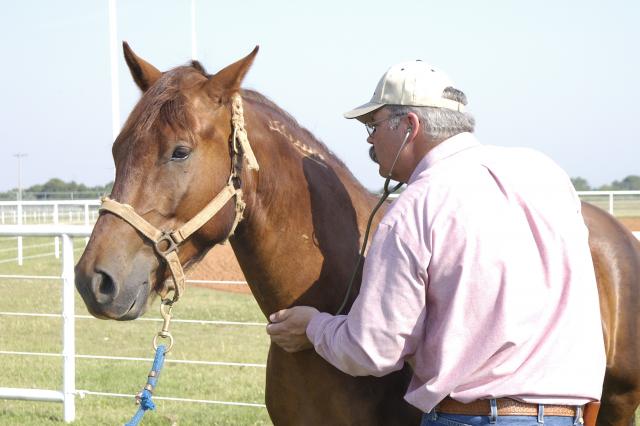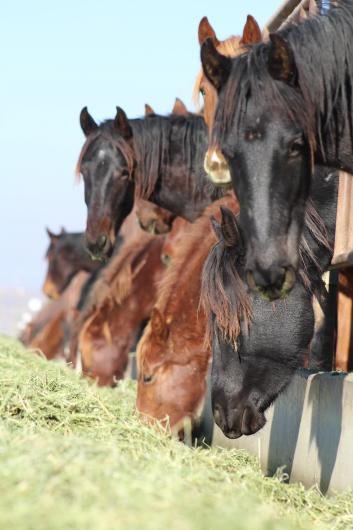You are viewing ARCHIVED content published online before January 20, 2025. Please note that this content is NOT UPDATED, and links may not work. Additionally, any previously issued diversity, equity, inclusion or gender-related guidance on this webpage should be considered rescinded. For current information, visit https://www.blm.gov/blog.
Infectious respiratory disease in wild horses and burros and how BLM responds to it
Although wild horses and burros are hardy and resilient creatures, they are susceptible to respiratory diseases just like their domestic cousins. While rare, respiratory infections do occur in the wild. However, respiratory conditions become more prevalent when the horses are housed in large groups following their removal from the range and during their transition to domestic life. Much like when a child goes to kindergarten, the change from living in small groups (one household of kids or a band of horses) to large groups living and interacting in close proximity (school classroom or a corral facility) increases the rate of spread of respiratory illnesses. The changing environment, higher stress levels and contact rate of animals that have had only limited prior exposure to respiratory bacteria and viruses means that outbreaks of respiratory illness do occur among wild horses and burros.

As part of the process for preparing wild horses and burros for domestic life after being gathered from public lands, the BLM vaccinates them for common equine diseases. These vaccines include tetanus, eastern and western equine encephalomyelitis, West Nile virus, rabies virus and the respiratory pathogens equine influenza (flu), equine rhinopneumonitis (rhino, caused by equine herpes viruses) and streptococcus equi (also known as strangles or equine distemper).
The BLM administers vaccinations to foals around 3-6 months of age depending on circumstances, and all the vaccines for adult horses and burros are administered and boostered as soon as possible after the animals arrive at a corral facility. It is a race against time to build immunity by vaccination while the animals are increasingly exposed to these viruses and bacteria in their new environment. Unfortunately, the respiratory diseases (flu, rhino and strangles) are highly contagious and difficult to control through vaccination alone. The vaccines may help limit how quickly and severely the illness spreads in a group setting, however, the infections also must run their course much like the common cold and flu for people. Often all the horses in a group will eventually become infected, with milder cases occurring among those animals with immunity from vaccines or a prior infection. While the infections can be carried home to our domestic horses on our hands or clothing, we generally can’t get sick from them.
Fortunately, infections with the respiratory flu and rhino viruses as well as the strangles bacteria are usually mild. They commonly cause fever, coughing and nasal discharge. Strangles often causes abscesses to develop under the chin and lower jaw. Some clinical signs include a high fever, thick, white nasal discharge and swollen lymph nodes under the jaw or throatlatch area. These usually resolve spontaneously without individualized treatment, but sometimes abscesses are open and drained if animals start having difficulty breathing (the origin of the term strangles).

If outbreaks occur in BLM facilities, the BLM works with a local attending veterinarian as well as state and Federal animal health officials as needed to examine and treat individual animals if necessary as well as control the infections by limiting their spread within and outside the facilities.
Respiratory infections in horses typically resolve with supportive care in 3 to 6 weeks. Generally, in a large group of animals living in a facility, it can take several months for these infectious outbreaks to run their course while the animals build herd immunity. During this time BLM may stop all animal movements in and out of facilities and cancel adoptions to reduce the risk of spreading illnesses into the domestic horse community.
All animals that BLM transports between states to facilities, adoptions and other events are examined by a veterinarian prior to shipping to ensure they are free from signs of infectious disease. Usually there is at least a 30-day waiting period after the animals seem to be healthy before they will be shipped out to an adoption. Despite these precautions, it can be difficult, particularly with wild horses, to identify animals that could still be contagious, and some animals can remain contagious for several months. Adopters should recognize that their new animals have very likely been exposed to infectious respiratory pathogens in the recent past. They should work with their attending veterinarian to go over the vaccination and deworming record provided at the time of adoption and quarantine their new animals away from those they have at home until their veterinarian feels it is safe to house them in close proximity or comingle them with their other animals.
For more information on respiratory and other diseases of horses and burros check out the BLM’s Care and Feed Guide or visit the Equine Disease Communication Center supported by the United States Department of Agriculture and the American Association of Equine Practitioners.
Related Content
Related Stories
- A good day for a wild burro named “Piper”
- National Conservation Lands: 25 years – and eons – in the making
- BLM publishes interactive web map displaying access to public lands
- BLM announces 2025 fee-free days
- Fourth Restoration Landscape film highlights Cosumnes Watershed fire and fuels reduction efforts
